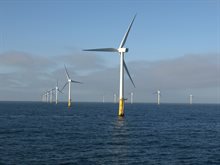Wind farms
Electricity generation in off-shore wind farms is a relatively new use function that demands a lot of space. At the start of 2007 the first off-shore wind farm, with 36 wind turbines, was created off the coast at Egmond aan Zee. Since then, the generation of green electricity from off-shore wind farms has become one of the cornerstones of the energy transition that is needed to achieve the climate objectives and, also, to reach a higher degree of self-sufficiency.

The effects of the creation of wind farms on nature have been discussed extensively. Pile-driving work for the foundations of off-shore turbines disturbs marine animals' ability to navigate and to communicate with each other over considerable distances. Operational wind farms form a permanent risk to birds and migrating bats. However, on the hard substrate of the turbine foundations, the opportunities for marine organisms to establish themselves underwater are increasing and, because trawler fishing is forbidden within wind farms and vessel movements are rare, 'oasis-like hot spots' of biodiversity may arise.
Considering all the effects, wind farms should not be regarded as nature-friendly. This is why the Netherlands does not designate wind farm zones in existing off-shore nature protection areas.